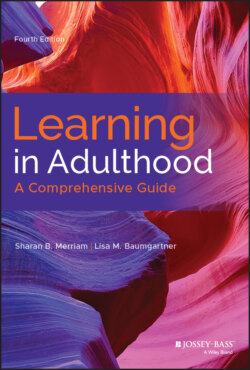Читать книгу Learning in Adulthood - Sharan B. Merriam - Страница 22
Community of Inquiry
ОглавлениеThe community of inquiry model focuses on creating cognitive, social, and teaching presences online (Garrison, 2017). Cognitive presence is “the exploration, construction, resolution, and confirmation of understanding through collaboration and reflection in a community of practice” (Garrison, 2007, p. 65). Social presence is “the ability to project one's self and establish personal and purposeful relationships” (p. 63). Social presence indirectly supports critical thinking and directly supports creating an enjoyable and fulfilling course (Garrison, Anderson, & Archer, 2000). Creating a teaching presence includes “the selection, organization, and primary presentation of course content, as well as the design and development of learning activities and assessment” (p. 90). This is most often accomplished by the teacher. Course facilitation can be shared by both the teacher and the learners (Garrison, Anderson, & Archer, 2000).
Cognitive presence means providing opportunities for critical thinking. Critical thinking has several components. There are “four phases of inquiry—triggering event, exploration, integration, and resolution” (Garrison, 2017, p. 26). Typically, individuals have an experience that leaves them puzzled. They search for information that might help them make sense of the issue and integrate that information to gain understanding or insights. The issue is resolved and they apply their knowledge to the problem.
Indicators of social presence include the expression of emotion. In an asynchronous course where text is the main method of communication, this is often achieved using emoticons, humor, and opportunities for self-disclosure (Garrison et al., 2000; Garrison, 2017). Self-disclosure promotes a sense of trust and belonging that can positively affect critical thinking, motivation, and persistence in a course. Another indicator of social presence is open communication. “Examples of open communication are mutual awareness and recognition of each other's contributions” (Garrison et al., 2000, p. 98). In an online support group for those living with multiple sclerosis, for example, revealing one's challenges and triumphs while coping with the disease can promote social presence. In a text-based course, replying to others' comments and complimenting others on their contributions are examples of how to increase social presence (Garrison et al., 2000). Group cohesion is a third category of social presence. Having individuals work on group projects together, meet weekly in small groups to discuss readings, or create course documents together can increase group cohesion.
The three types of teaching presence indicators are instructional management, building understanding, and direct instruction. Instructional management consists of deciding the curriculum, assignments, and assessments. Building understanding includes managing the community of inquiry so learners can create meaning. This encompasses drawing out those who are less active, managing discussion, and acknowledging learners' contributions (Garrison et al., 2000). Direct instruction consists of having learners discuss and reflect on course content and guiding learners by asking questions and providing feedback (Garrison et al., 2000).
The community of inquiry framework has been used to “investigate students' level of knowledge construction in asynchronous discussions” (Liu & Yang, 2014, p. 327). For example, undergraduate students in an information ethics course engaged in asynchronous discussion on “theory exploration, life experience, case-based, and debate discussion” (p. 327). Students were most satisfied with the life experience discussions and scored highest on knowledge construction (cognitive presence) and social presence in this type of discussion. Case-based discussions also yielded high knowledge construction scores. For best results concerning knowledge construction, Liu and Yang (2014) recommended that teachers use case-based discussion combined with current events or students' life experiences rather than purely discussing theory or debating an issue. Other topics have included examining cognitive, social, and teaching presences in an English as a foreign language (EFL) teachers' discussion list (Nami, Marandi, & Sotoudehnama, 2018), interrelationships among the three types of presence (Kozan & Richardson, 2014), and scaffolding social presence in online courses (Hoskins, 2013). The community of inquiry model would also fit well with other online communities of practice such as groups for nurses and social workers. Critics point out that researchers using this framework rely too heavily on self-reports for perceived learning and researchers do not provide enough evidence to show that students engage in deep and meaningful learning when this framework is used for empirical studies (Rourke & Kanuka, 2009).
